How to Fix a Bicycle Pump

Manually operated bicycle pumps are essentially piston and cylinder machines that compress air and force it into the inner tube. Floor pumps, frame pumps and foot pumps all have same primary parts that are prone to failure--the hose and related fittings and the seal at the end of the piston rod, known as the leather.
Check for leaks in the hose assembly by holding your finger against the valve fitting at the end of the hose and operating the pump for one or two strokes. If the hose or fittings are bad, air will hiss out at the valve fitting (pump head), the base of the pump, or through the hose itself.
Replace cracked or broken hoses with a new hose. Hoses must withstand high pressure and patches seldom hold.
Repair a leaking pump head by unscrewing the nut and replacing the seal. If the head is leaking at the connection to the hose, replace the connector with an adjustable hose clamp.
Tighten a leaking fitting at the pump end of the hose where it screws into the base of the pump. If this doesn’t fix the problem, remove and replace the connection with a new hose clamp.
Fix a faulty leather by removing the rod assembly from the pump barrel. If the leather is split or perforated, replace it. If it appears dry or warped, lubricate it generously with light multi-purpose grease or heavy oil.
Warnings
When lubricating a pump, use a light grease or heavy oil. Don't use automotive axle grease.
Warnings
- When lubricating a pump, use a light grease or heavy oil. Don't use automotive axle grease.
Writer Bio
Meg Jernigan has been writing for more than 30 years. She specializes in travel, cooking and interior decorating. Her offline credits include copy editing full-length books and creating marketing copy for nonprofit organizations. Jernigan attended George Washington University, majoring in speech and drama.
